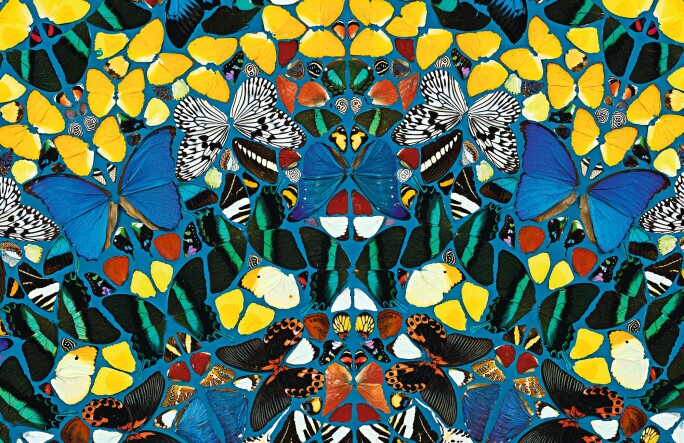Soulful and Lovers by Damien Hirst, two works on offer in the Contemporary Art Hong Kong Evening Sale on 9 July 2020, capture the heart wrenching beauty and fragility of life. Both confronting the dichotomies of life and death, science and religion, Soulful and Lovers are conceptually rigorous and aesthetically astounding specimens from Hirst’s provocative successful career.
D elivering a resplendent mosaic of red, emerald, amber and turquoise, the poignantly titled Soulful is a mesmerizing example of Damien Hirst’s kaleidoscopic Butterfly Grid Paintings. Radiating celestial beauty, the work comprises thousands of delicately patterned butterfly wings laid on a monochromatic surface. While the symmetry and iridescence of the composition evokes a carefully-constructed Renaissance Tondo of fine stained glass, the intricate and alluring patterns affirm the superior artistry of natural forces.
The painting is rife with religiosity; indeed, its title – Soulful – evokes an act of spiritual meditation. Hirst’s acclaimed Butterfly Grid Paintings serve as rumination on his most important concern – death as channeled through the two dominating belief structures of contemporary existence: religion and science. Hirst has unerringly questioned modern-day attitudes to mortality and the role of art in relation to these belief structures, discussing the redemptive powers of art and his belief that it should be – like religion or science – an affirmative force: “Art’s got to be positive, even if it’s about negative things… I think you can always apply art to life in a positive way”.


By appropriating the visual language of stained-glass windows, themselves indelibly associated with great cathedrals, Christianity, and religious iconography, Hirst has aligned his work with the symbolic and metaphysical concerns that characterise those belief systems. The fear of mortality and the aspiration to eternal life are central to religion; Hirst’s meditation on this desire is suggested by his use of butterfly wings rather than glass, as their presence necessarily implies their demise, yet their lasting beauty in his canvas offers another form of life.
Within Hirst’s deliberate artistic lexicon, the butterfly has come to signify the soul itself, evoking both the ephemerality and the abiding joy of life. As he has famously declared, “'I think I've got an obsession with death, but I think it’s like a celebration of life rather than something morbid. You can’t have one without the other” (Damien Hirst in: Gordon Burn and Damien Hirst, On the Way to Work, London 2011, p. 21).
Also on offer in the Hong Kong Contemporary Art Evening Sale is Lovers, another work that rivetingly distills the emphases of Damien Hirst’s oeuvre. On a formal level, there is an unabashed formal beauty in the shimmering opulent topaz juxtaposed against the glittering gold and mirrored vitrine. However, Hirst’s purpose here is not simply aesthetic, but rather to hold a mirror to our collective response and aversion to death.

Executed over a decade after the first Pill Cabinets, which date from the end of the 1990s, Hirst here replaces pills with topaz stones, arranging them meticulously in glass shelves encased in a gold-plated stainless-steel cabinet. The crystalline permanence of the stones, which unlike real pills would not dissolve once ingested, reflects the feeling of the eternal which the promise of pharmaceutical products espouses.
Lovers’ dense conceptual content and wry social commentary are conveyed through a composition of shimmering reflective beauty that is laced with art-historical reference and executed with a sense of dissident creative verve. By replacing the pills of his earlier Medicine Cabinets with precious stones, Hirst conflates the mundane and the exalted and furthermore places emphasis on how manufactured perfection renders its contents impotent and functionless.
“I can’t understand why most people believe in medicine and don’t believe in art, without questioning either.”
An alterpiece to modern medicine, Lovers taps into our blind credence in the restorative life-giving powers of pills. Where the encrusted platinum cast of Hirst’s 2007 For the Love of God functioned as a resplendent effigy of death, here the topaz stones in Lovers function as dazzlingly immaculate modern day memento mori. If each one exists as a tiny promise of the extension of life, then their unified message is a deafening reminder of the inevitability of death.
The reflective surfaces also visually implicate the viewer in the facile struggle for survival which gives Lovers its conceptual bent, and the razor-sharp edges of the shelves imply a degree of danger inherent in the process of self-medication. In emblematising each tablet in this impressive work of mesmeric beauty, Hirst both mocks society’s belief in them, and offers us an alternative: “I’ve always really loved this idea of art, maybe, you know, curing people” (the artist cited in Damien Hirst and Gordon Burn, On the Way to Work, London 2001, p. 25).







